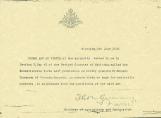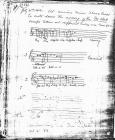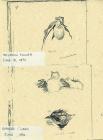1
On August 19, 1883 Seton writes to a friend, Jack Willing, in Toronto, whom he addresses as My Dear Jack. A quote tells volumes about Seton's activities at the time, "The usual inquiry, of one student of another is: What are you doing? Well, some farming, a little drawing and a good deal of Nat History.". Further along in the letter Seton explains that part of his objective with the stay in Carberry is to carry out research for a publication he is planning. In his words, "I confess I have never omitted an opportunity of collecting matter sultable for a small popular work in Birds, I for long kept my purpose to mself but found that I was therby losing many helps & therefore I now confess (underlined). I so often find the history of some plant or insect interwoven with that of the land in hand that I make a point of giving some acct. of both. In consquence I have had to sketch many of our wild flower, & will have to get drawings of many Ontarian flowers.2
Letter of Permission to Seton for studies of birds or eggs by Manitoba Agriculture and ImmigrationJune 6, 1892
Winnipeg, Manitoba
 Credits:
Credits:The Seton Centre, Carberry, Manitoba, Canada
3
Seton listened to and recorded the characteristic sounds of the birds he encountered.1882
Carberry Sandhills, Carberry, Manitoba, Canada
 Credits:
Credits:The Seton Centre, Carberry, Manitoba, Canada
4
A page of Seton's sketches from his daily journal, bird, flora and small creature.June 1892
Carberry Sandhills, Carberry, Manitoba, Canada
 Credits:
Credits:The Seton Centre, Carberry, Manitoba, Canada
5
"Meadowlark in Song" by Ernest Thompson Seton1883
Carberry, Manitoba, Canada
 Credits:
Credits:Philmont Museum-Seton Memorial Library, Cimarron, New Mexico, USA
6
Marsh Hawk, watercolor by Ernest Thompson Seton1890
Carberry, Manitoba, Canada
 Credits:
Credits:Philmont Museum-Seton Memorial Library, Cimarron, New Mexico, USA